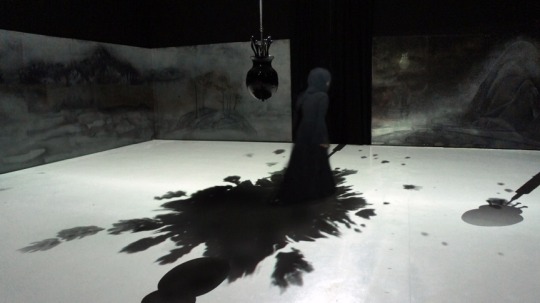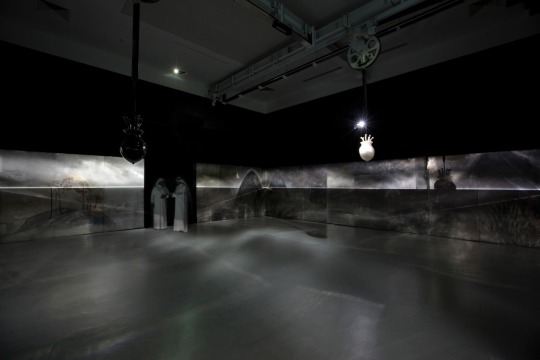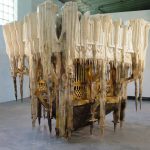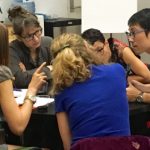Vision, Art and Opera: An Interview with Jennifer Wen Ma
“But that is the beauty of the work – the sparks and inspiration that others bring with it.”
Jennifer Wen Ma is an interdisciplinary artist working across installation, drawing, video, public art, design, performance and theatre. Her fiscally sponsored project Paradise Interrupted was granted a FY2016 NYSCA Award in Film & Media / New Tech Production. A 2003 NYFA Fellow in Performance Art/Multidisciplinary Work, Ma’s practice has been shared in galleries, museums, public spaces and theaters. Her recent international exhibitions include projects at Cass Sculpture Foundation in the UK and Qatar Museums. Ma generously shared her time with NYFA Current to discuss her practice and the forthcoming performance of Paradise Interrupted at the Lincoln Center Festival this summer.
What: Paradise Interrupted Opera at Lincoln Center Festival
When: July 13–16, 2016 at 8 PM
Where: Gerald W. Lynch Theater 524 West 59th Street (Between 10th and 11th Avenues)
Tickets: Click here for more information
NYFA: As creative director and producer of numerous different events and exhibits, notably a member of the core creative team for the 2008 Summer Olympics in Beijing, you possess significant experience coordinating large-scale events. How did you initially become involved with these productions and how do these experiences inform your practice as an individual artist?
Jennifer Wen Ma (JWM): I entered a bid that the Beijing Organizing Committee for the Olympic Games (BOCOG) called out globally in 2005 for creative proposals, where they received more than 600 entries. My team of New York based artists was one of the finalists. I was then chosen as a part of the 7-member core creative team that oversaw the entire event. It was a life defining experience, and has had lasting influence on me artistically. I learned some profound lessons about scale, vision, in-depth research, the spirit and art of collaboration, and tirelessly pushing oneself for always a little more.
NYFA: From ink and paper to interactive technology, lighting and set design, I imagine you employ different modes of thinking when working with different media. What informs your interest and continued practice in interdisciplinary work?
JWM: I am first and foremost driven by concepts. Once I have an idea, I try to think of the best delivery of the concept. Hence, sometimes the form and media can be quite varied from project to project. I like pushing the boundaries of my comfort zones and predictable way of working.
NYFA: Your large scale performances and installations rely on many partners to carry out your artistic vision. How do you ensure your work is manifested in accordance with your creative goals, while also making space for others’ talent and input to ultimately benefit the work?
JWM: I find that if collaboration is a part of the concept at the start of the work – whether it is collaboration with the public or other artists – then you have to embrace the process and take it as far as it can take you, even if it means losing control of it. But that is the beauty of the work – the sparks and inspiration that others bring with it.

NYFA: The Metropolitan Opera broadcasts nationally in movie theaters, bringing opera to communities who might not otherwise have been exposed to the genre, while simultaneously allowing new audiences to fall in love with it. What was your introduction to opera like? When did you become interested in the connections and differences between opera’s Eastern and Western iterations?
JWM: I have had an ongoing fascination and love for opera over the years, but mostly as personal enjoyment. However I hadn’t entertained the idea of making an opera until recent years when I saw how theatrical space and temporal works can open up new possibilities for the audience during an aesthetic experience. In approaching the concept of East vs West, it is not a subject I actively think about per se. Rather, given that I am steeped and active in both the artistic practices and traditions, it is natural to use elements from all my references and create a work that could embody seemingly different elements in a seamless and creative way.
NYFA: What sparked your interest connecting the Garden of Eden and Peony Pavilion storylines in Paradise Interrupted?
JWM: I was researching about the Garden of Eden and biblical creation myth around 2013 for a museum exhibition. I was also studying Peony Pavilion at the same time and learning about kunqu opera as an art form. As I delved deeper into both stories, I saw the parallel between Eve and Duliniang as women who had experienced utopian bliss but had to face the cruel reality of losing it. I became curious about the idea of an alternate path for these women to search and regain their paradise. The word ‘paradise’ comes from ancient Iranian meaning ‘walled enclosure’. So the idea of paradise has been associated with a boundary from the start. Humans have been trying to break out of, or into, paradise for a long time, either in the form of leaving the Garden of Eden, or a child rebelling against the parental home but then building a new home of his/her own and trying to recreate paradise. I saw the universal appeal of the story and how it can have deep personal resonance for each viewer.

NYFA: At Performa 13 you shared excerpts of Paradise Interrupted as part of a workshop and a few weeks ago at the Asia Society excerpts of Paradise Interrupted were paired with a panel discussion. Why do you choose to share the performance outside of traditional theatre settings and what do you hope your audiences will gain from these experiences?
JWM: I believe in reaching out to and educating the public whenever I can. I also do a lot of talks at schools, universities, libraries, corporations, foundations, and theatrical settings. It is about reaching the widest spectrum of audience, especially important since opera is seen as such a rarified art form these days. With this outreach, I hope to pique the audience’s curiosity and interest, and share the journey of making the work to demystify the creative process.
NYFA: Why did you choose fiscal sponsorship for Paradise Interrupted and what is its influence on this project?
JWM: In 2003, I received a Fellowship from NYFA. In retrospect, it was quite seminal in my artistic development, as it was early in my career and was such an encouragement and supportive boost that I so needed.
When I spoke with some foundations that were interested in supporting Paradise Interrupted, but required a non-profit that hosted fiscal sponsorship, NYFA became a natural choice for me. I am pleased to be back in the fold of NYFA and its community. I thought it could also be a way for me to give back a little bit as well. These sponsorship grants have allowed me as an artist, and my creative team, to have more space and time to explore, create and make great work that we all believe in. I am very proud to bring installation opera Paradise Interrupted to the New York audience on July 13, 15, and 16 as a part of the Lincoln Center Festival. Thank you!
NYFA Fiscal Sponsorship allows individual artists and emerging arts organizations in all disciplines the ability to raise funds using NYFA’s tax-exempt status as a 501©(3)-classified organization. Under NYFA’s fiscal sponsorship, artists and organizations can optimize the reach of their fundraising efforts. Deadlines for the program are quarterly; learn more here.
Image credits: Photographs of Jennifer Wen Ma’s installation, The Furthest Distance in a Paradise Interrupted at the Qatar Museums by Wen-You Cai, Cindy Ma and Wen-You Cai.





